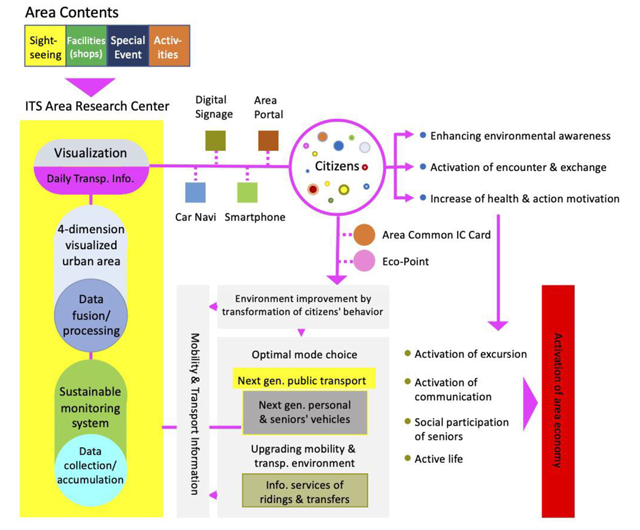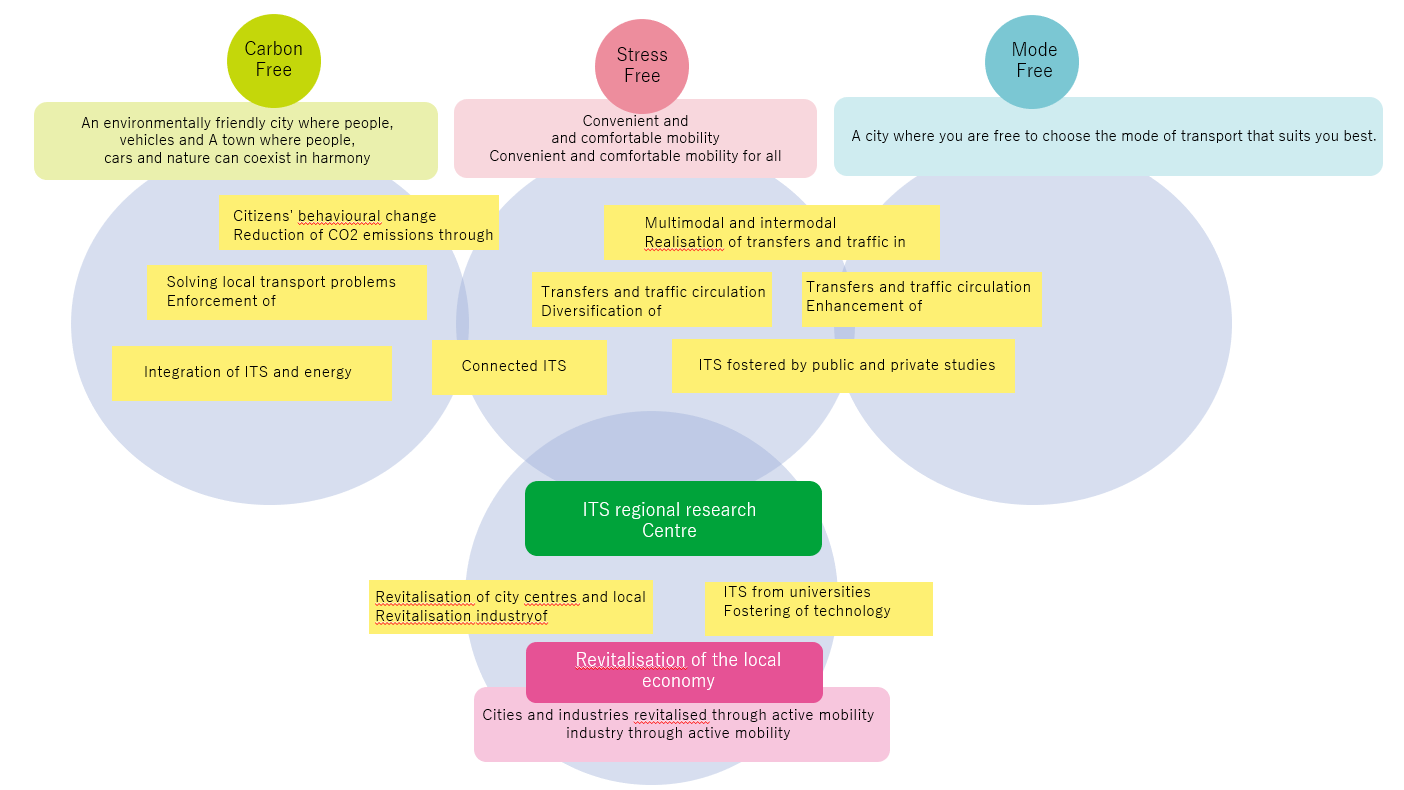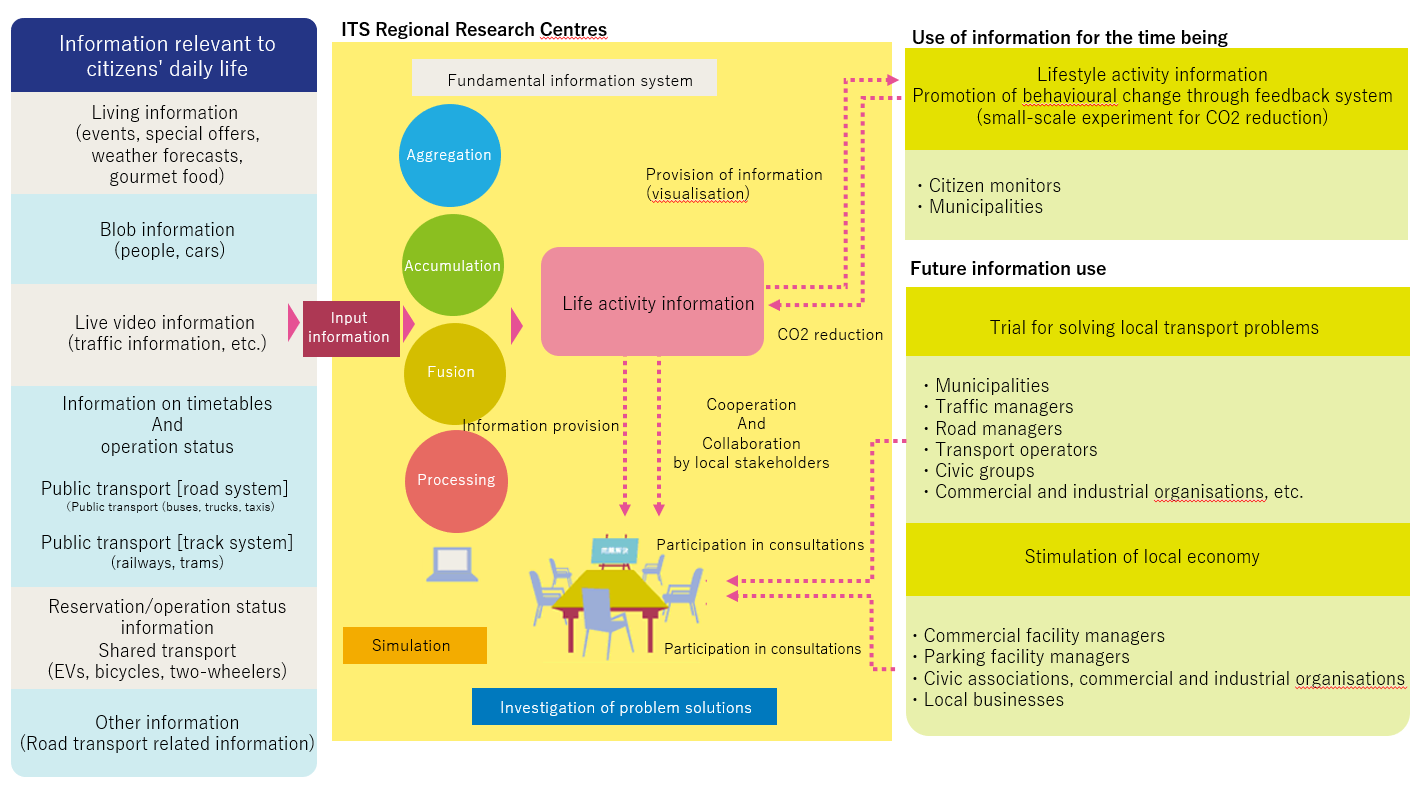Kashiwa ITS Smart City will grow together with people and the community
Kashiwa ITS Smart City can be summed up in one phrase: “ITS that grows together with people and communities. Various types of movement and traffic information are collected, accumulated, and processed using state-of-the-art ITS technology, and visualized as information on daily life activities, which in turn helps each citizen to become more aware of what kind of traffic behavior is beneficial to the community and environment, and to take action. As a result of the continuous circulation of such information, the burden on the environment is reduced, traffic congestion is eased, people and goods move more actively, and the community is revitalized. The positive spiral centered on the transportation system is what we are aiming for with “ITS, which grows together with people and the community.
The most important of all is the diversity and ease of understanding of information on daily life activities. It is precisely because this information is closely related to people’s daily lives that it is possible to raise citizens’ awareness and encourage them to proactively change their behavior. Of course, it is also essential to develop and improve means of transportation and transportation systems to support such behavioral change. It is important to create a transportation system that is more efficient and convenient, a variety of transportation options that meet the needs and objectives of each citizen, and a transportation environment that is easy for everyone to use. A key feature of Kashiwa ITS Smart City is that it will continue to grow while linking easy-to-understand lifestyle activity information, the citizens who use it, and the transportation systems that support their actions.
Kashiwa ITS Smart City Aims for Three Freedoms and Revitalization of the Local Economy
The key words for understanding ITS, which grows together with people and communities, are “three freedoms.
Kashiwa ITS Smart City will encourage citizens to change their behavior by providing them with visualized information on their daily activities. It has already been proven through demonstration experiments that the approximately 400,000 citizens of Kashiwa, some of whom have switched from private cars to public transportation, can reduce a considerable amount of CO2 emissions by devising new travel methods, or so-called “carbon-free” transportation. In addition, the use of information on daily life activities can help avoid traffic congestion and facilitate smooth connections, thereby realizing a “stress-free” travel/transportation environment. Of course, in order to realize these goals, it is necessary to provide a variety of means of travel and transportation. Kashiwa ITS Smart City will realize a “mode-free” environment in which everyone can freely choose the mode of transportation that suits them, both haplike and personal.
The realization of the three modes of free travel will motivate citizens to take action and encourage active outings and circulation. Activation of people’s movement will lead to new encounters, discoveries, and enjoyment, and will encourage active community activities and consumption behavior. As a result, it will promote the revitalization of the local economy. This is our vision of regional revitalization through ITS.
ITS Regional Research Center” to Promote Collaboration among ITS Stakeholders in the Region
Introduction
Although road traffic in Japan has shown signs of improvement in terms of accidents, traffic congestion, environmental pollution, and other problems at the national level due to the implementation of road traffic policies, accidents and traffic congestion in large and medium-sized cities are in need of further improvement. Kashiwa City, Chiba Prefecture, with its busy National Routes 16 and 6, has chronic traffic congestion on major arterial roads, as well as serious traffic jams and parking lot shortages in the central city area. The city is in need of an urgent solution to this problem as the region’s transportation administration.
Kashiwa ITS Smart City,” a model for a sustainable transportation society based on ITS
To address these issues, Kashiwa City established the Kashiwa ITS Promotion Council in February 2010, bringing together local governments, universities, traffic managers, road administrators, civic groups, commerce and industry organizations, private companies, and other stakeholders. The Council is currently working to build a “Kashiwa ITS Smart City” that will realize a sustainable transportation society based on ITS.
The concept of the “Kashiwa ITS Smart City” is “three freedoms (carbon-free, stress-free, mode-free) and revitalization of the local economy. To realize this concept, various individual ITSs are currently being implemented in the “Kashiwa ITS Smart City. The ITS Regional Research Center is at the center of these efforts.
Role of the ITS Regional Research Center
The ITS Regional Research Center will not only bundle the individual ITSs implemented in “Kashiwa ITS Smart City,” but will also collect information related to the daily lives of citizens using the latest sensor technology, and then aggregate, store, fuse, and process this information using the latest information processing technology to create new information that will be useful for citizens’ mobility and activities. This new information will be useful for citizens’ mobility and activities.
This lifestyle activity information was used in a social experiment conducted by the Strategic Information and Communications R&D Promotion Project (SCOPE) of the Ministry of Internal Affairs and Communications (MIC) from FY2011 to FY2013 to see how much CO2 can be reduced by visualizing and providing this information to citizens to promote behavioral changes in citizens.
In the future, it is also considered that the information on daily life activities can be used to discuss how to solve local road traffic problems with local stakeholders and how to revitalize the local economy through discussions among commerce and industry, citizen groups, local businesses, and other stakeholders.
ITS Regional Research Center” to Promote Collaboration among ITS Stakeholders in the Region
(1) Operational structure
- 1. Expanding the role of universities
- Until now, universities have been primarily involved in research and development related to ITS, with little involvement in practical applications. The Advanced Mobility Research Center (ITS Center) of the Institute of Industrial Science, the University of Tokyo, has decided to actively engage in research on the practical application of ITS, and since 2014, the “ITS Regional Research Center” has been managed and operated as a research organization of the ITS Center, with the cooperation of related organizations.
- 2. System Operation
- For the time being, the ITS Regional Research Center will be managed and operated as a research organization of the ITS Center, but in the future, when it is ready to operate independently, we plan to transfer its operation to, for example, a consortium, a public-private partnership such as a third sector organization, or a university-launched venture company.
- 3.Cooperation among related parties
- In order to smoothly and efficiently promote the solution of regional road traffic problems and the revitalization of regional economies through ITS, it is essential to have cooperation and collaboration among local governments, universities, traffic managers, road administrators, civic groups, commerce and industry organizations, private companies, and other related parties with on-site knowledge and a thorough understanding of the needs of citizens. The ITS Regional Research Center will provide a forum for discussion and a variety of data, including information on daily life activities, in order to make the discussions among these parties more useful. We believe that the ITS Regional Research Center will be a trump card for the practical application of ITS in the region.
(2)Business Model
The most important practical application measure is a business model for the center’s self-sustaining operation. To this end, the ITS Center aims to commercialize the “ITS Regional Research Center” as a university-originated ITS technology. For example, we are considering increasing the value of life activity information to make it commercially viable, providing consultancy services for local road traffic problems using life activity information, and selling packages of evaluation methods for environmental improvement measures in local cities.
(3) Social experiments
An important step in developing an experimental system into a practical system is social experimentation. Social experiments are an important means of communicating between ITS adopters, such as local governments, and citizens, who are the users of the system. The experimental system will show citizens the way of thinking of the ITS provider, and their opinions will be reflected in the system to develop it into a better practical system.



